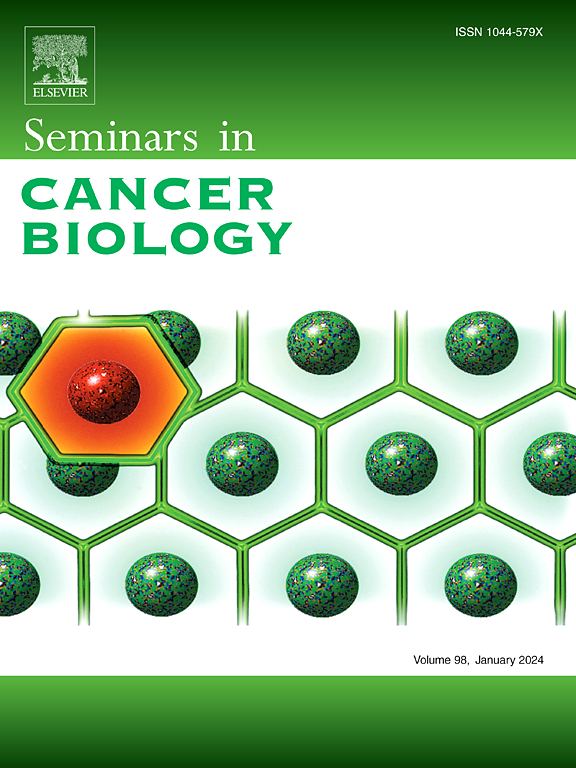组织蛋白酶:肿瘤生态系统中克服癌症的新靶点
IF 12.1
1区 医学
Q1 ONCOLOGY
引用次数: 0
摘要
组织蛋白酶是一组溶酶体肽酶,传统上被认为是肿瘤促进剂。然而,最近的研究强调了它们在协调癌症和肿瘤微环境(TME)中的关键作用。首先,组织蛋白酶降解细胞外基质,使癌细胞侵袭和转移,同时也促进血管内皮浸润和随后的血管生成。此外,组织蛋白酶促进成纤维细胞生长,从而支持肿瘤进展。更重要的是,组织蛋白酶通过调节TME内的免疫细胞募集、抗原加工和递呈、分化和细胞死亡,在调节免疫细胞方面起着关键作用,主要有助于免疫抑制。考虑到组织蛋白酶在肿瘤中的过度表达和癌症患者血液循环中的水平升高,考虑组织蛋白酶的全身作用是至关重要的。尽管组织蛋白酶在癌症患者体内的全面作用尚未得到充分研究,但它们可能通过其独特的蛋白水解功能影响全身免疫和炎症、细胞代谢、肌肉萎缩和远处转移。值得注意的是,组织蛋白酶还通过重写TME内的细胞谱来赋予对放化疗的耐药性。在这种背景下,将组织蛋白酶抑制剂与常规疗法结合起来有效抑制肿瘤发展的研究正在出现有希望的结果。本综述旨在解读癌细胞和TME内组织蛋白酶驱动的网络,详细介绍它们通过重塑微观和宏观环境对放化疗耐药的贡献。此外,我们探讨了当前和未来针对组织蛋白酶相互作用的治疗观点,为创新治疗策略提供见解。本文章由计算机程序翻译,如有差异,请以英文原文为准。
Cathepsins: Emerging targets in the tumor ecosystem to overcome cancers
Cathepsins, a group of lysosomal peptidases, have traditionally been recognized as tumor facilitators. Recent research, however, highlights their critical role in orchestrating cancer and the tumor microenvironment (TME). Primality, cathepsins degrade extracellular matrix, enabling cancer cells to invade and metastasize, while also promoting vascular endothelial infiltration and subsequent angiogenesis. Additionally, cathepsins boost fibroblast growth, thereby supporting tumor progression. More importantly, cathepsins are pivotal in modulating immune cells within the TME by regulating their recruitment, antigen processing and presentation, differentiation, and cell death, primarily contributing to immune suppression. Given their overexpression in tumors and elevated levels in the circulation of cancer patients, it is crucial to consider the systemic effects of cathepsins. Although the comprehensive role of cathepsins in cancer patients’ bodies remains underexplored, they likely influence systemic immunity and inflammation, cellular metabolism, muscle wasting, and distant metastasis through their unique proteolytic functions. Notably, cathepsins also confer resistance to chemoradiotherapy by rewriting the cellular profile within the TME. In this context, promising results are emerging from studies combining cathepsin inhibitors with conventional therapies to suppress tumor development effectively. This review aims to decipher the cathepsin-driven networks within cancer cells and the TME, detailing their contribution to chemoradioresistance by reshaping both micro- and macroenvironments. Furthermore, we explore current and future perspectives on therapies targeting cathepsins’ interactions, offering insights into innovative treatment strategies.
求助全文
通过发布文献求助,成功后即可免费获取论文全文。
去求助
来源期刊

Seminars in cancer biology
医学-肿瘤学
CiteScore
26.80
自引率
4.10%
发文量
347
审稿时长
15.1 weeks
期刊介绍:
Seminars in Cancer Biology (YSCBI) is a specialized review journal that focuses on the field of molecular oncology. Its primary objective is to keep scientists up-to-date with the latest developments in this field.
The journal adopts a thematic approach, dedicating each issue to an important topic of interest to cancer biologists. These topics cover a range of research areas, including the underlying genetic and molecular causes of cellular transformation and cancer, as well as the molecular basis of potential therapies.
To ensure the highest quality and expertise, every issue is supervised by a guest editor or editors who are internationally recognized experts in the respective field. Each issue features approximately eight to twelve authoritative invited reviews that cover various aspects of the chosen subject area.
The ultimate goal of each issue of YSCBI is to offer a cohesive, easily comprehensible, and engaging overview of the selected topic. The journal strives to provide scientists with a coordinated and lively examination of the latest developments in the field of molecular oncology.
 求助内容:
求助内容: 应助结果提醒方式:
应助结果提醒方式:


